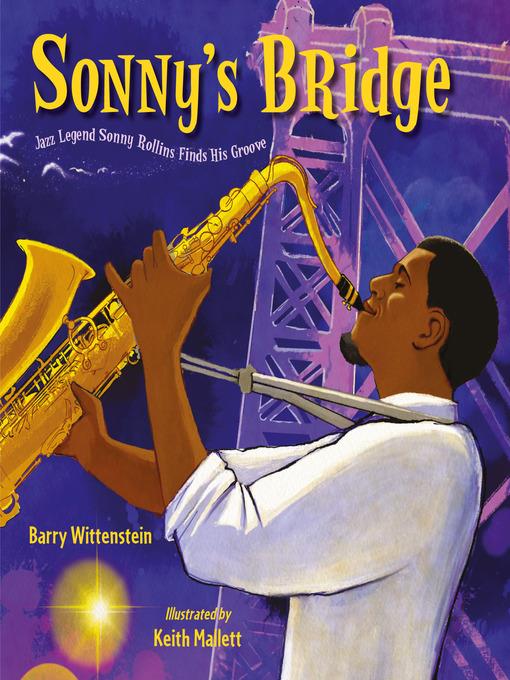
Sonny's Bridge
Jazz Legend Sonny Rollins Finds His Groove
فرمت کتاب
ebook
تاریخ انتشار
2019
Lexile Score
480
Reading Level
1-2
نویسنده
Keith Mallettناشر
Charlesbridgeشابک
9781632897381
کتاب های مرتبط
- اطلاعات
- نقد و بررسی
- دیدگاه کاربران
نقد و بررسی

March 15, 2019
An appropriately jazzy picture-book biography of African-American musician Sonny Rollins.It impresses from the endpapers, which mirror a vinyl LP in its paper sleeve and then playing on a turntable, to the liner notes about Rollins' seminal album "The Bridge" in the back. Born and raised in Harlem, Rollins grew up at the perfect time for a jazz musician. Written in free verse that flirts with rhyme, the text moves through measures and beats like the up-and-down swings of jazz. The vibrant, digitally created illustrations set the mood as they go from deep blue and purple nighttime hues to bright daytime tones and back again. The birth of Rollins' career is explored as he acquires and falls in love with his first horn and learns the nuances of jazz by sneaking into some of the greatest clubs in Harlem. By the time he's 19 people have started to notice how great he truly is. He spends most of the 1950s playing two shows a day, every day. Ten years later he needs a sabbatical: "Sonny knows if he don't jump, / He. Won't. Last." He practices on the Williamsburg Bridge, and the first album after his return is called "The Bridge." Child readers may not have thought much about Rollins, but Wittenstein's admiration for his subject establishes his importance. All the characters present as African-American.Opens the door for further exploration of both man and music. (Picture book/biography. 3-9)
COPYRIGHT(2019) Kirkus Reviews, ALL RIGHTS RESERVED.

May 6, 2019
This insightful biography of Sonny Rollins opens with two New Yorkers hearing the sound of saxophone: “What the heck is Sonny Rollins doing on the Williamsburg Bridge?” Wittenstein turns back the clock as Mallett depicts formative moments from Rollins’s life alongside concurrent historical events: Rollins is born at the time of the Harlem Renaissance, and discovers a love for saxophone as WWII soldiers march and eventually give way to civil rights demonstrators. After Rollins’s music career launches and he “rockets to the top of the jazz universe,” the book fast forwards to Rollins’s mid-career moment of crisis: “Looks in the mirror,/ doesn’t like what he sees./ Name bigger than talent.” Seeking a private place to play (Rollins leans dejectedly on his fire escape, his saxophone resting against the railing, the sun setting over the Manhattan skyline), he finds solace in practicing on the bridge, which connects “the old to the new,” and leads to a new recording. Wittenstein fluidly provides historical context while exploring the ebbs and flows of the artistic process. Back matter discusses Rollins’s The Bridge album. Ages 6–9.

Starred review from May 1, 2019
Gr 1-4-The life of jazz legend Sonny Rollins pulses with the rousing spontaneity of his music in Wittenstein's free verse biography. Readers witness Rollins's career as an acclaimed musician followed by his explosive success and the subsequent reincarnations of his art. When Rollins feels like his career is one out-of-control improvisation, he ducks out of the limelight, devoting days and nights to playing his sax on the Williamsburg Bridge. On that bridge, he does some soul-searching; after two years, he returns to the spotlight as a more confident, grounded musician. Wittenstein's verse replicates the swift tempo of bebop, interspersing rhyme and combining informal vernacular with a sense of extemporization in the rhythm. Some words, such as "per-co-lat-ing," are punctuated at every syllable, each striking like a staccato note. Others are emphasized in all caps and are onomatopoeic ("BOOM BOP BEBOP!"). Mallett's smooth, bold illustrations are rendered in dusky purples, moody blues, and earth tones: colors suggesting notes of jazz swirling through a thick night sky. An author's note, liner notes to Rollins's seminal album, The Bridge, a time line, and additional content provide an opportunity for further exploration. VERDICT Pair with Rollins's music to introduce children to this legendary musician and to the rhythmic exuberance of jazz.-Melissa Williams, Berwick Academy, ME
Copyright 2019 School Library Journal, LLC Used with permission.

May 1, 2019
Grades 1-3 Walter Theodore Sonny Rollins was born during the Jazz Age in the cradle of the Harlem Renaissance. After WWII, jazz slowly morphed into bebop, and Sonny was in the middle of it. Overwhelmed by early fame, the young saxophonist decided to take a break from the limelight?until the siren song called again, and he began practicing on the Williamsburg Bridge, away from complaining neighbors. The text is divided into sets, framing the narrative within larger historical moments, and Wittenstein presents the story in jaunty, lyrical phrasings. He also works in the titles of famous standards like Stompin' at the Savoy and Take the ?A' Train. Mallett's palette alternates between royal purples and sandy browns, with the digital art seeming to glow during Sonny's highs and dim during his lows. The back matter details some of his heavier moments, including issues with substance abuse, and it mentions a current-day project to rename the Williamsburg Bridge after Rollins. A good choice for collections in need of biographies focused on music or lesser-known African American musicians.(Reprinted with permission of Booklist, copyright 2019, American Library Association.)

























دیدگاه کاربران